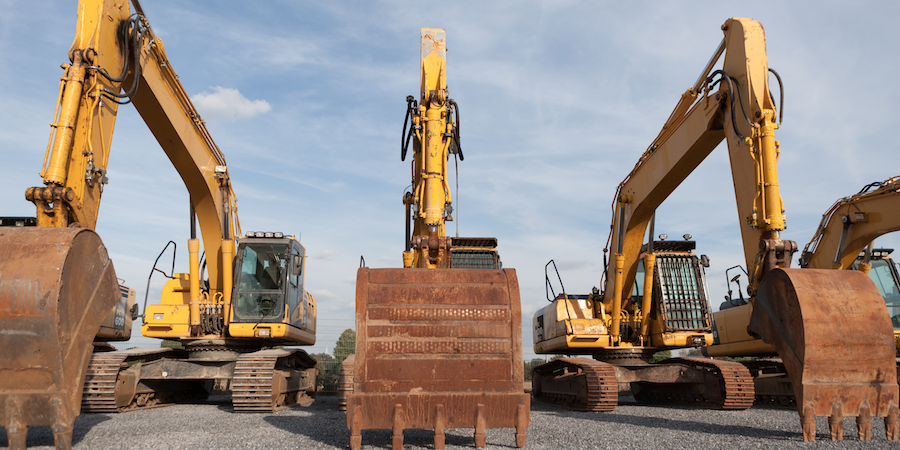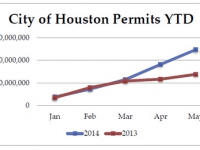Starts jump in June, Reed says; several reports point to growth in diverse segmentsin MayEditor’s note: Construction Citizen is proud to partner with AGC America to bring you AGC Chief Economist Ken Simonson's Data DIGest. Check back each week to get Ken's expert analysis of what's happening in our industry.The value of nonresidential construction starts in June jumped 14% compared with June 2013, Reed Construction Data reported Friday, based on data it collected. Cumulative starts for the first half of 2014 exceeded January-June 2013 starts by 2.4%. Nonresidential building starts slipped 3.1% year-to-date, with a 14.5% drop in commercial starts offsetting gains of 5.9% for institutional buildings and 13.5% for industrial (manufacturing). Heavy engineering starts rose13% year-to-date.
Reshaping the Construction Industry
This past week, the Austin Chapter AGC Safety Committee visited with Marco Ramos, who was recently hired to enforce the City of Austin's rest break ordinance for construction workers. Ramos discussed his new compliance role and said he proactively visits sites and also responds to complaints lodged via the City's 311 phone system. Typically, the first thing he looks for on site is the required signage to be posted per the ordinance. He also talks with workers about rest breaks and water availability.
July 12, 2014
The Austin School Board recently voted to adopt Davis-Bacon federal wage rates on construction of facilities under the district's new $490 million bond package. While some have hailed this as a historic step, it is seen by many as merely a short-term fix for attracting workers into the skilled trades. In short: more needs to be done.After a hot debate, the board narrowly voted 5 to 4 to adopt Davis-Bacon wage rates. The crowd in the board room erupted into applause. It's good news for some, but not for all. As public radio in Austin pointed out, pay will go up for those in trades like electricians and security technicians, but others like general laborers will actually see their wages go down to the point where they will be earning less than $8 an hour.Trustee Cheryl Bradley joined with three others in voting against Davis-Bacon wage rates, arguing that it made no sense. “You’re not going to be buying food for your family on $7.75 an hour,” Bradley said. “You’re not going to be paying rent. You will be on government subsidy.”
July 09, 2014
The following article originally appeared in the July newsletter to clients of Kiley Advisors, LLC for the purpose of providing the latest leading indicators and industry issues to those clients. Reprinted with permission.The construction market continues to be on fire. CBRE’s early preview of the second quarter shows all sectors are still busy. Office absorption and asking rates are up quarter over quarter. It is the same story in light industrial and retail with the latter reportedly having 2.7 msf under construction in the second quarter.Multi-family has 25,000 units under construction in the greater Houston area. The rising rates in apartments have two primary drivers.
July 08, 2014
June employment, May spending rise for construction; most metros add jobs in MayEditor’s note: Construction Citizen is proud to partner with AGC America to bring you AGC Chief Economist Ken Simonson's Data DIGest. Check back each week to get Ken's expert analysis of what's happening in our industry.Nonfarm payroll employment rose by 288,000, seasonally adjusted, in June and 2,495,000 (1.8%) over 12 months, the Bureau of Labor Statistics (BLS) reported last Thursday. Construction employment rose by 6,000 for the month and 186,000 (3.2%) over the year to 6,015,000, the highest total since June 2009. Residential construction employment (residential building and specialty trade contractors) climbed by 6,600 for the month and 106,300 (4.9%) for the year. Nonresidential employment (building, specialty trades, and heavy and civil engineering construction) was flat in May and up 80,000 (2.2%) year-over-year. All five residential and nonresidential segments added workers over 12 months. Aggregate hours worked in construction increased 3.2% over 12 months, while average hourly earnings rose 2.3%.
July 07, 2014
The Construction Citizen team has been tracking the progress of worker misclassification laws across the country, including the newly minted crackdown in Tennessee. Elizabeth McPherson wrote about that when it was first passed last year. Now we get word out of Nashville that a drywall contractor based in Music City has agreed to pay more than $300,000 in penalties for understating his payroll and misclassifying workers to avoid paying the required taxes and workers compensation insurance.
July 03, 2014
“What If?”What if your construction company had the opportunity to secure K-12 construction work with the largest school district in the State of Texas?What if you had the right crews to bid, win, and execute the work?What if your craft workers could be safe, make a livable wage, and have the promise of several years of work on your construction jobs?If you are in the K-12 construction industry in Houston, your “what ifs” could become reality with the Houston Independent School District (HISD) bringing an approved $1.89 billion bond, seven-year construction program to market consisting of 40 schools, three athletic facilities, and numerous renovations.With all this work in the market, what more could a serious career-minded construction company ask for its workers?
July 02, 2014
Mine is Taller than Yours. Why? Beats me!That conversation is going on around the world as developers find the available financing to buy in the inner city and to satisfy the new and the ultra wealthy’s demand for high-rise living – not to mention the demand from the old and wealthy.It is interesting, as we have noted previously, that engineering and technology have made it possible to build higher with faster elevators, sustainable systems, new wind technology, and new materials able to withstand the stresses. It is interesting from a real estate viewpoint that the sites seem to be smaller and the buildings taller, especially in the inner-city environment. All the conveniences that we proposed in the last century have become a reality, and we have owners and tenants who are willing to build them.Justin McGar writes in a recent issue of Sourceable.net about the 31 tall buildings under construction and the 43 proposed additional new skyscrapers recently approved in Melbourne, Australia. He writes about the ways that engineering is making it possible for developers to dream taller dreams for their new buildings.
July 01, 2014
40 states, DC add jobs in May; surveys show varied trends for housing, nonres activityEditor’s note: Construction Citizen is proud to partner with AGC America to bring you AGC Chief Economist Ken Simonson's Data DIGest. Check back each week to get Ken's expert analysis of what's happening in our industry.Seasonally adjusted construction employment increased in 40 states and the District of Columbia from May 2013 to May 2014 and decreased in 10 states, an AGC analysis of Bureau of Labor Statistics (BLS) data released on June 20 showed. The largest percentage gains were in Nevada (13%, 7,000 jobs), Florida (9.8%, 35,300) and Minnesota (9.7%, 9,700). California added the most jobs (37,300, 5.9%), followed by Florida and Texas (26,500, 4.3%). The steepest 12-month percentage losses occurred in West Virginia (-6.3%, -2,200), New Jersey (-6.2%, -8,500) and Montana (-5.7%, -1,400). New Jersey lost the most construction jobs, followed by Arizona (-4,100, -3.3%). For the month, 30 states and D.C. added construction jobs, 19 states lost jobs and Alaska had no change.
June 30, 2014
“A global jobs war is coming and there is no time to waste. Cities are crumbling for lack of good jobs. Nations are in revolt because their people can’t get good jobs. The cities and countries that act first—that focus everything they have on creating good jobs—are the ones that will win.” - Jim Clifton, Chairman of Gallup and author of The Coming Jobs War.Today’s shortage of skilled workers began in the last century when the focus on the need for high tech workers for the new industrial revolution became a vision of everyone getting a four-year college education. Technology was “the answer” and while it has proven a true driver for that sector of the economy, today we still see the shortages that were predicted in the late 90s in the engineering and high tech space. Now we are even seeing calls from many of the super successful entrepreneurs that claim that a college education is unnecessary. They just want to see “your code.” The world has changed. Today, we are in a major jobs shortage in all of the skilled trades, not just in the STEM arena. What happened?Programs like “No Child Left Behind,” charter schools, STEM programs and magnet schools emerged to meet the need that was being unfulfilled by the public school systems that were essentially “dumbing down” our kids to the lowest common denominator of education, while simultaneously shouting that every child should go to college if they were to be successful in the “new economy.”
June 27, 2014



.jpeg?itok=6uFZXEBH)





.jpeg?itok=4Vi_1nJG)































